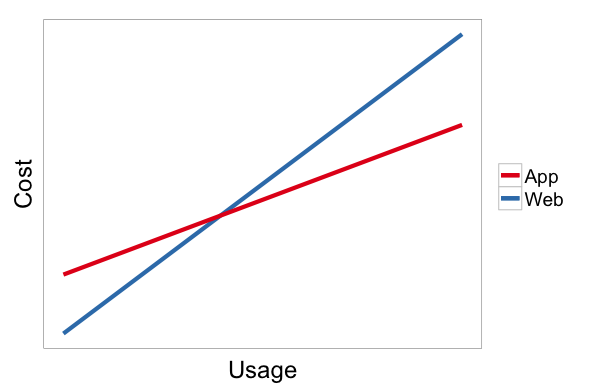The difference between using an app and a website is in terms of the costs. The app reduces the per-transaction cost, thanks to customisations and additional user information it possesses. There is a fixed cost in using the app, though, in terms of time, memory and bandwidth incurred in installing it, and user data that the app collects.
The costs of using an app versus using a website, as a function of the number of transactions, is illustrated in the figure here (this is simplified but not far from the truth):
 This is the graph you need to keep in mind when you are trying to take your product app-only or web-only. Labels from the graph have been removed on purpose.
This is the graph you need to keep in mind when you are trying to take your product app-only or web-only. Labels from the graph have been removed on purpose.
For low levels of usage, there is no point in installing an app (unless the reduction in marginal cost is dramatic), for the fixed cost is not going to justify the benefit that the app offers. When the usage is high, it makes sense for the user to install the app, since the fixed cost will amortise over the larger number of transactions.
When a service goes app-only (as is the fashion in India nowadays), it loses the long tail of low volume users who see no value in incurring the fixed cost of keeping the app. On the other hand, a web-only service is likely to lose power users since they have to incur the higher marginal cost each time.
So if you are starting a new service and are wondering whether to launch the service on app first or web first, think of the frequency with which your customers will be using the service, and the incremental value you can add if they use the app (be realistic about these estimates). If it is either a high-frequency service (like email or news, for example) or a service where the value added through the app is massive (like Uber, which can read the user’s location), you better lead with an app.
On the other hand, if the service is low-frequency and the quality of experience in app and web need not be dramatically different, it makes sense to lead with the web offering and add an app later only to hold on to your power users.
From this perspective, I’m not convinced of the logic of Indian companies such as Flipkart and Myntra (which are shopping sites, which most users don’t use that often) to go app only. India being a ‘mobile-first’ nation is at best an excuse.
Postscript
The above graph also explains why businesses offer attractive incentives to customers to install the app – to mitigate the high fixed cost of installation. The problem is that the fixed cost is borne not just during installation but also over time (app occupying phone space, snooping on you and sending you notifications), so smart users take advantage of these incentives and uninstall the apps after immediate use.